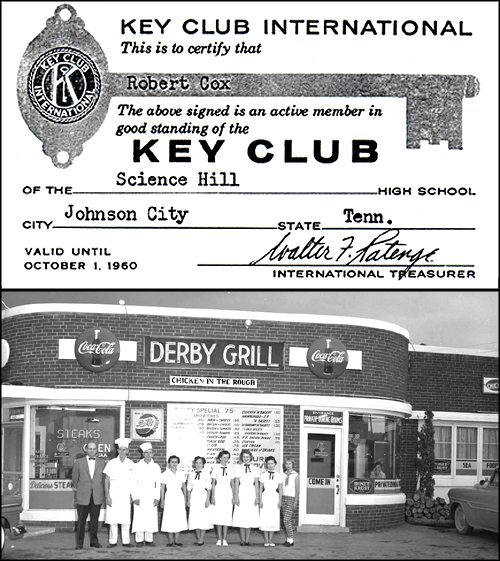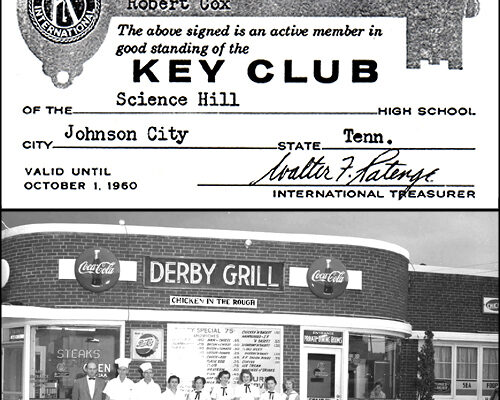On July 19, 1959, I received a letter from the president of the Science Hill High School Key Club, a student all male organization sponsored by the city’s Kiwanis Club, inviting me to join this group.
The Key Club was under the strong guidance of the school’s PMST (Professor of Military Science and Tactics), Captain John Culpepper. Student officers during my junior year were Johnny Starnes (pres.), Guy Wilson (v.p.), Eddie Broyles (sec.) and Eddie Washburn (treas.). Our club sweetheart was Betty Gale Young. Senior year officers were Bill Wood (pres.), Kip Carr (v.p.), Butch Tysinger (sec.), and Howard Cothran (treas). The club sweetheart was Carol Ann Greene.

Initially, we met once a month at the Broadway Court Restaurant on North Roan. Later, we briefly switched to the Derby Grill on West Market and finally settled down at Dinty Moore’s Restaurant on E. Market. Our club’s mission somewhat mirrored that of our parent club; we were a service club interested in promoting our high school.
Each month, the Kiwanis Club invited a Key Clubber to attend its meeting at the John Sevier Hotel, which was a quick dash across Roan Street. I vividly recall the meeting I attended mainly because the guest speaker was the colorful Fire Chief L.L. Geisler, who delivered a brief message promoting “Fire Prevention Week,” which began that week. The Johnson City Press-Chronicle gave a brief write-up about it the next day.
Capt. Robert Wilson showed a film entitled, “Before They Happen,” depicting the efforts to prevent and minimize fires. Howard White, club president, praised Chief Geisler for his long record of service noting that Johnson City had less fire loss than any city in the nation. Guests were then introduced that included Dr. Fred McCune of Johnson City, Dick Owen of the Training School Key Club and myself.
According to a 1934 school newspaper article, the first Key Club at Science Hill was formed in 1933 with H.A. Lee and Roy Bigelow serving as school advisors. Student officers that year were Joe Jamison (pres.), Phil Carr (v.p.), Bill Willien (recording sec.), Leonard Bevis (corresponding sec.) and Carl Marshall (treas.).
The organization had three stated objectives: foster vocational guidance, train members in correct parliamentary procedure and have fellowship. Club organizers sent out questionnaires to 15 high schools all over the country where similar clubs existed. Feedback was used to help prepare the club’s Constitution and outline club activities.
A 1949 newspaper article suggests that the Key Club was dropped sometime between 1935 and 1948, most likely during the war years when so many male students entered military service. The 1949 clipping speaks of the Kiwanis Club organizing a Key Club at SHHS that year. The committee, headed by Sam Grogg and assisted by Steve Lacy, Joe Cox, Ed Wright and John McKell, met frequently with Principal Howard McCorkle to establish the club.
Charter members were Darrell Mullins (pres.); Tommy Coleman (v.p.); Charles Day (sec.); Selbert Marks (treas.); Glenn Stroup; Robert Moffatt; Leddy Alan Ottinger; Robert Lee Spencer; George Crisp, Jr.; Jimmy Seehorn, Jr.; Ambers Wilson, Jr.; Charles Fredrick Stamm; Jim R. Green; James Roland Berry; Reuben Treadway; Clarence Willard Sapp; Bob McFall; and Jim Overbay. To celebrate the occasion, a joint dinner meeting was held with Kiwanis Club members, Key Clubbers and their parents.
Sadly, school officials tell me that the Key Club ceased operation again several years ago. Perhaps this laudable organization will spring forth a third time to benefit future generations of high school students, both male and female.
